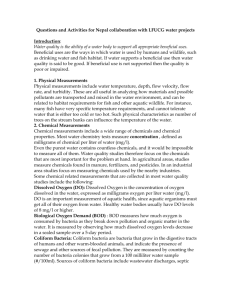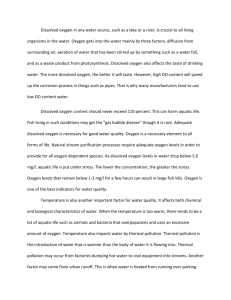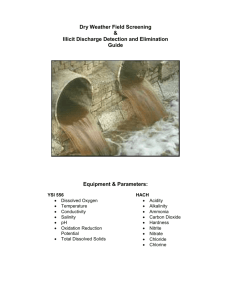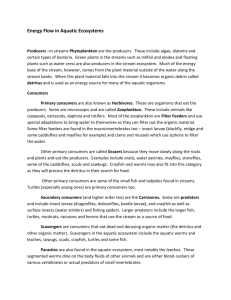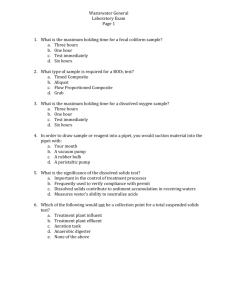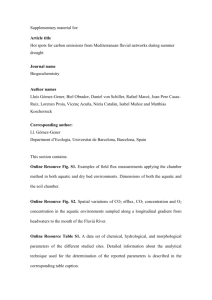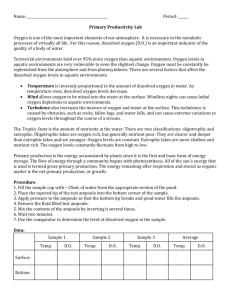GLTG Glossary Outline - IC 12.4.14
advertisement
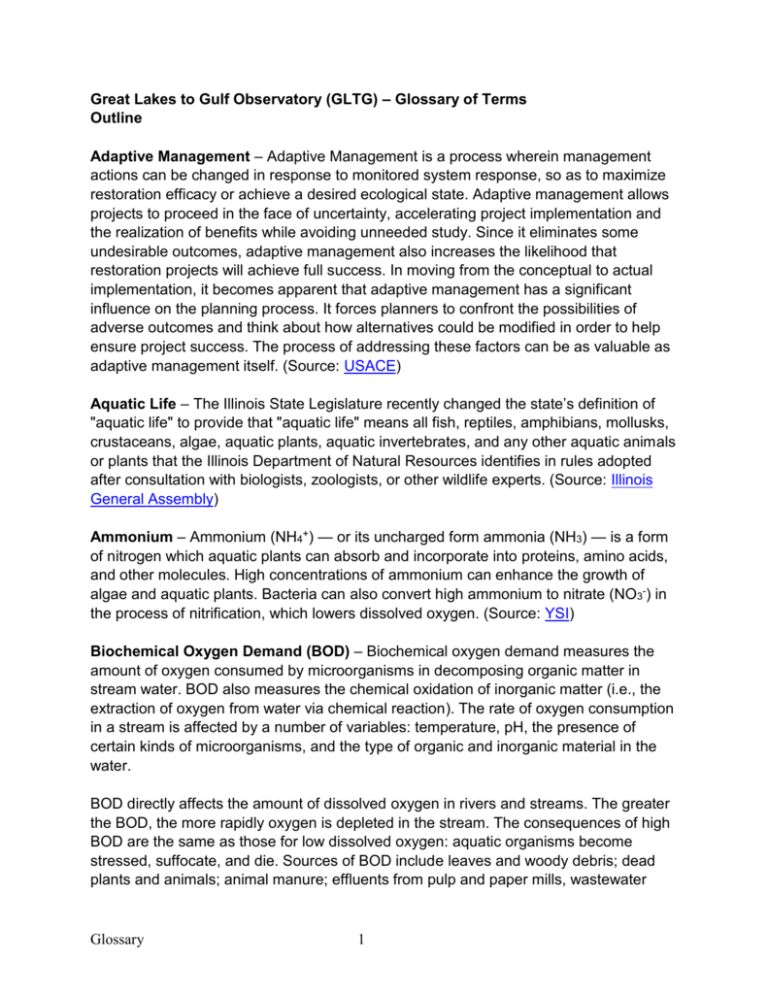
Great Lakes to Gulf Observatory (GLTG) – Glossary of Terms Outline Adaptive Management – Adaptive Management is a process wherein management actions can be changed in response to monitored system response, so as to maximize restoration efficacy or achieve a desired ecological state. Adaptive management allows projects to proceed in the face of uncertainty, accelerating project implementation and the realization of benefits while avoiding unneeded study. Since it eliminates some undesirable outcomes, adaptive management also increases the likelihood that restoration projects will achieve full success. In moving from the conceptual to actual implementation, it becomes apparent that adaptive management has a significant influence on the planning process. It forces planners to confront the possibilities of adverse outcomes and think about how alternatives could be modified in order to help ensure project success. The process of addressing these factors can be as valuable as adaptive management itself. (Source: USACE) Aquatic Life – The Illinois State Legislature recently changed the state’s definition of "aquatic life" to provide that "aquatic life" means all fish, reptiles, amphibians, mollusks, crustaceans, algae, aquatic plants, aquatic invertebrates, and any other aquatic animals or plants that the Illinois Department of Natural Resources identifies in rules adopted after consultation with biologists, zoologists, or other wildlife experts. (Source: Illinois General Assembly) Ammonium – Ammonium (NH4+) — or its uncharged form ammonia (NH3) — is a form of nitrogen which aquatic plants can absorb and incorporate into proteins, amino acids, and other molecules. High concentrations of ammonium can enhance the growth of algae and aquatic plants. Bacteria can also convert high ammonium to nitrate (NO3-) in the process of nitrification, which lowers dissolved oxygen. (Source: YSI) Biochemical Oxygen Demand (BOD) – Biochemical oxygen demand measures the amount of oxygen consumed by microorganisms in decomposing organic matter in stream water. BOD also measures the chemical oxidation of inorganic matter (i.e., the extraction of oxygen from water via chemical reaction). The rate of oxygen consumption in a stream is affected by a number of variables: temperature, pH, the presence of certain kinds of microorganisms, and the type of organic and inorganic material in the water. BOD directly affects the amount of dissolved oxygen in rivers and streams. The greater the BOD, the more rapidly oxygen is depleted in the stream. The consequences of high BOD are the same as those for low dissolved oxygen: aquatic organisms become stressed, suffocate, and die. Sources of BOD include leaves and woody debris; dead plants and animals; animal manure; effluents from pulp and paper mills, wastewater Glossary 1 treatment plants, feedlots, and food-processing plants; failing septic systems; and urban stormwater runoff. (Source: EPA) Blue Green Algae – Blue-green algae (BGA) is actually cyanobacteria, and can range in colors from blues, greens, reds, and black. BGA can reduce nitrogen and carbon in water, but can also deplete dissolved oxygen when overabundant. Monitoring BGA is important because they pose a serious threat to water quality, ecosystem stability, surface drinking water supplies, and public health through toxin production and the large biomass produced in algal blooms. (Source: YSI) Chlorophyll a – Chlorophyll in various forms is bound within living cells of photosynthetic organisms, such as phytoplankton and cyanobacteria (blue-green algae). The amount of chlorophyll found in a water sample is used as a measure of the concentration of phytoplankton. These measurements contribute to the understanding of the general biological “health” of the system, such as its trophic status or primary production. Chlorophyll measurements can also identify algal bloom events and their effects on water quality and anticipate toxic algal blooms. Chlorophyll fluoresces when irradiated with light of a particular wavelength (435-470 nm). For field measurements, in-situ fluorometers induce chlorophyll to fluoresce by shining a beam of light of the proper wavelength into the water and then measuring the emitted, higher wavelength light. These real-time chlorophyll measurements complement extractive lab analysis. (Source: YSI) Conductivity – Conductivity is a measure of the ability of water to pass an electrical current. Conductivity in water is affected by the presence of inorganic dissolved solids such as chloride, nitrate, sulfate, and phosphate anions (ions that carry a negative charge) or sodium, magnesium, calcium, iron, and aluminum cations (ions that carry a positive charge). Organic compounds like oil, phenol, alcohol, and sugar do not conduct electrical current very well and therefore have a low conductivity when in water. Conductivity is also affected by temperature: the warmer the water, the higher the conductivity. For this reason, conductivity is reported as conductivity at 25 degrees Celsius (25 C). Conductivity in streams and rivers is affected primarily by the geology of the area through which the water flows. Conductivity data can determine concentration of solutions, detect contaminants and determine the purity of water. GREON unit conductivity sensor measures conductivity by AC voltage applied to nickel electrodes. These electrodes are placed in a water sample (or other liquid), where the current flows through the electrodes and the sample. Current level has a direct relationship with the conductivity of the solution. (Sources: EPA, YSI) Glossary 2 Contaminants – Emerging Contaminants? Delta – Deltas are wetlands that form as rivers empty their water and sediment into another body of water, such as an ocean, lake, or another river. Deltas can also empty into land, although this is less common. A river moves more slowly as it nears its mouth, or end. This causes sediment, solid material carried downstream by currents, to fall to the river bottom. The slowing velocity of the river and the build-up of sediment allows the river to break from its single channel as it nears its mouth. Under the right conditions, a river forms a deltaic lobe. A mature deltaic lobe includes a distributary network—a series of smaller, shallower channels, called distributaries, that branch off from the mainstem of the river. In a deltaic lobe, heavier, coarser material settles first. Smaller, finer sediment is carried farther downstream. The finest material is deposited beyond the river's mouth. This material is called alluvium or silt. As silt builds up the delta forms, extending a river's mouth into the body of water into which it is emptying. A delta is sometimes divided into two parts: subaqueous and subaerial. The subaqueous part of a delta is underwater. This is the most steeply sloping part of the delta, and contains the finest silt. The newest part of the subaqueous delta, furthest from the mouth of the river, is called the prodelta. The subaerial part of a delta is above water. The subaerial region most influenced by waves and tides is called the lower delta. The region most influenced by the river's flow is called the upper delta. Past decades of river management has prevented the Mississippi River from naturally flowing through its delta wetlands, causing erosion. Between 1990 and 2000, the Mississippi River Delta lost 62 square kilometers (24 square miles) of wetlands per year. (Source: National Geographic) Discharge or Stream Flow or Flow Rate – Stream flow, or discharge, is the volume of water that moves over a designated point over a fixed period of time. It is often expressed as cubic feet per second (ft3/sec). The flow of a stream is directly related to the amount of water moving off the watershed into the stream channel. It is affected by weather, increasing during rainstorms and decreasing during dry periods. It also changes during different seasons of the year, decreasing during the summer months when evaporation rates are high and shoreline vegetation is actively growing and removing water from the ground. Flow is a function of water volume and velocity. It is important because of its impact on water quality and on the living organisms and habitats in the stream. Large, swiftly Glossary 3 flowing rivers can receive pollution discharges and be little affected, whereas small streams have less capacity to dilute and degrade wastes. Stream velocity, which increases as the volume of the water in the stream increases, determines the kinds of organisms that can live in the stream (some need fast-flowing areas; others need quiet pools). It also affects the amount of silt and sediment carried by the stream. Sediment introduced to quiet, slow-flowing streams will settle quickly to the stream bottom. Fast moving streams will keep sediment suspended longer in the water column. Lastly, fast-moving streams generally have higher levels of dissolved oxygen than slow streams because they are better aerated. (Source: EPA) Dissolved Oxygen – Oxygen is measured in its dissolved form as dissolved oxygen (DO). The stream system both produces and consumes oxygen. It gains oxygen from the atmosphere and from plants as a result of photosynthesis. Running water, because of its churning, dissolves more oxygen than still water, such as that in a reservoir behind a dam. Respiration by aquatic animals, decomposition, and various chemical reactions consume oxygen. If more oxygen is consumed than is produced, dissolved oxygen levels decline and some sensitive animals may move away, weaken, or die. Since dissolved oxygen levels are directly related to good water quality, the two are highly interdependent. Many factors can affect DO levels, and an understanding of these levels in order to make informed decisions concerning wastewater treatment operations, hypoxic zones, aquaculture facilities or large-scale ecosystems is essential. (Sources: EPA, YSI) Drainage Area – The term "drainage area" is defined as the land area where precipitation falls off into creeks, streams, rivers, lakes, and reservoirs. It is a land feature that can be identified by tracing a line along the highest elevation between two areas on a map, often a ridge. Larger drainage basins contain many smaller drainage basins, often called watersheds. The drainage area for a river basin is measured in a horizontal plane enclosed by the drainage divide outlining the basin. In some cases river basins may have non-contributing sub-basins, or commonly called enclosed basins, where the runoff stays within the basin and not contributing to the larger basin surrounding the enclosed basin. (Source: USGS) Flood – Floods are one of the most common hazards in the United States. Anywhere it rains, it can flood. A flood is a general and temporary condition where two or more acres of normally dry land or two or more properties are inundated by water or mudflow. However not all floods are alike with some floods developing slowly, while others such as flash floods, develop in just a few minutes and without visible signs of rain. Additionally, floods can be local, impacting a neighborhood or community, or very large, affecting entire river basins and multiple states. Glossary 4 Many conditions can result in a flood: hurricanes, overtopped levees, outdated or clogged drainage systems and rapid accumulation of rainfall. Overland flooding, the most common type of flooding event typically occurs when waterways such as rivers or streams overflow their banks as a result of rainwater or a possible levee breach and cause flooding in surrounding areas. (Source: Ready.gov, NFIP) Flood Risk – Flooding can happen anywhere, but certain areas are especially prone to serious flooding. Flood risk can be informed by history, but risk is also based on a number of factors: rainfall, river-flow and tidal-surge data, topography, flood-control measures, climate change, and changes due to building and development. To help communities understand their risk, flood maps (Flood Insurance Rate Maps, FIRMs) have been created to show the locations of high-risk, moderate-to-low risk and undetermined-risk areas. Special Flood Hazard Areas (SFHA): In high-risk areas, there is at least a 1 in 4 chance of flooding during a 30-year mortgage. All home and business owners in these areas with mortgages from federally regulated or insured lenders are required to buy flood insurance. They are shown on the flood maps as zones labeled with the letters A or V. Non-Special Flood Hazard Areas (NSFA): In moderate-to-low risk areas, the risk of being flooded is reduced but not completely removed. These areas submit over 20% of NFIP claims and receive one-third of disaster assistance for flooding. Flood insurance isn't federally required in moderate-to-low areas, but it is recommended for all property owners and renters. They are shown on flood maps as zones labeled with the letters B, C or X (or a shaded X). Undetermined Risk Areas: No flood-hazard analysis has been conducted in these areas, but a flood risk still exists. Flood insurance rates reflect the uncertainty of the flood risk. These areas are labeled with the letter D on the flood maps. (Source: NFIP) Gulf of Mexico Hypoxic Zone – The hypoxic zone in the northern Gulf of Mexico is an area along the Louisiana-Texas coast, where water near the bottom of the Gulf contains less than 2 parts per million of dissolved oxygen, causing a condition referred to as hypoxia. Each summer, the size of the hypoxic zone is measured. The size of the zone is an important indicator of how much progress is being made to reduce nutrient inputs into the Gulf of Mexico. Sometimes the size of the zone is influenced by other factors, such Glossary 5 as droughts or hurricanes that can reduce the size of the zone, or floods that can increase the size. (Source: EPA) Hydrologic Unit Code (HUC) – The United States is divided and sub-divided into successively smaller hydrologic units which are classified into four levels: regions, subregions, accounting units, and cataloging units. The hydrologic units are arranged or nested within each other, from the largest geographic area (regions) to the smallest geographic area (cataloging units). Each hydrologic unit is identified by a unique hydrologic unit code (HUC) consisting of two to eight digits based on the four levels of classification in the hydrologic unit system. (Source: USGS) Hydrology – Hydrology is the science that encompasses the occurrence, distribution, movement and properties of the waters of the earth and their relationship with the environment within each phase of the hydrologic cycle. The water cycle, or hydrologic cycle, is a continuous process by which water is purified by evaporation and transported from the earth's surface (including the oceans) to the atmosphere and back to the land and oceans. All of the physical, chemical and biological processes involving water as it travels its various paths in the atmosphere, over and beneath the earth's surface and through growing plants, are of interest to those who study the hydrologic cycle. (Source: USGS) Hypoxia – Hypoxia, meaning low oxygen, occurs when dissolved oxygen levels are too low to support aquatic organisms creating “dead zones.” The causes of hypoxia include excess nutrients in the water column, which facilitate algal blooms and phytoplankton growth. The phytoplankton soon die and decompose, consuming oxygen in the process, which causes the death of aquatic organisms that cannot escape to areas with higher oxygen levels. Although the Gulf’s waters are rich in oxygen, a process called stratification, caused by the natural layering of fresh water from the river and salt water from the Gulf, prevents the two from mixing and keeps the dead zone in place for months at a time. Direct effects of hypoxia include fish kills, which deplete valuable fisheries and disrupt ecosystems. The Gulf of Mexico hypoxic zone is located in the northern Gulf of Mexico off the coast of Louisiana and Texas. The zone was first documented in 1972. (Source: EPA) Infrastructure Macroinvertebrates – Macroinvertebrates are organisms that are large (macro) enough to be seen with the naked eye and lack a backbone (invertebrate). They inhabit all types of running waters, from fastflowing mountain streams to slowmoving muddy Glossary 6 rivers. Examples of aquatic macroinvertebrates include insects in their larval or nymph form, crayfish, clams, snails, and worms (Fig. 4.1). Most live part or most of their life cycle attached to submerged rocks, logs, and vegetation. Being relatively easy to sample and identify, aquatic macroinvertebrates are good indicators of stream quality because they are affected by the physical, chemical, and biological conditions of the stream. The basic principle behind the study of macroinvertebrates is that some are more sensitive to pollution than others. Therefore, if a stream site is inhabited by organisms that can tolerate pollution and the more pollution sensitive organisms are missing a pollution problem is likely. (Source: EPA) Nitrate – Nitrates are a form of nitrogen, which is found in several different forms in terrestrial and aquatic ecosystems. These forms of nitrogen include ammonia (NH3), nitrates (NO3), and nitrites (NO2). Nitrate forms in water when bacteria use dissolved oxygen to oxidize ammonium. Nitrates are essential plant nutrients, but in excess amounts they can cause significant water quality problems. Together with phosphorus, nitrates in excess amounts can accelerate eutrophication, causing dramatic increases in aquatic plant growth and changes in the types of plants and animals that live in the stream. This, in turn, affects dissolved oxygen, temperature, and other indicators. Excess nitrates can cause hypoxia (low levels of dissolved oxygen) and can become toxic to warm-blooded animals at higher concentrations (10 mg/L) or higher) under certain conditions. The natural level of ammonia or nitrate in surface water is typically low (less than 1 mg/L); in the effluent of wastewater treatment plants, it can range up to 30 mg/L. Sources of nitrates include wastewater treatment plants, runoff from fertilized lawns and cropland, failing on-site septic systems, runoff from animal manure storage areas, and industrial discharges that contain corrosion inhibitors. (Sources: EPA, YSI) Nitrogen (Total) – Nutrients – Nutrient Pollution – Nutrient pollution is one of America's most widespread, costly and challenging environmental problems, and is caused by excess nitrogen and phosphorus in the air and water. Nitrogen and phosphorus are nutrients that are natural parts of aquatic ecosystems. Nitrogen and phosphorus support the growth of algae and aquatic plants, which provide food and habitat for fish, shellfish and smaller organisms that live in water. But when too much nitrogen and phosphorus enter the environment - usually from a wide range of human activities - the air and water can become polluted. Nutrient Glossary 7 pollution in ground water - which millions of people in the United States use as their drinking water source - can be harmful, even at low levels. Nutrient pollution has impacted many streams, rivers, lakes, bays and coastal waters for the past several decades, resulting in serious environmental and human health issues and negative economic impacts. Too much nitrogen and phosphorus in the water causes excessive algal growth or algal blooms that harm water quality, food resources and habitats, and decrease the oxygen that aquatic life need to survive. Some algal blooms are harmful to humans because they produce elevated toxins and bacterial growth that can make people sick if they come into contact with polluted water, consume tainted fish or shellfish, or drink contaminated water. (Source: EPA) Phosphorous – Both phosphorus and nitrogen are essential nutrients for the plants and animals that make up the aquatic food web. Since phosphorus is the nutrient in short supply in most fresh waters, even a modest increase in phosphorus can, under the right conditions, set off a whole chain of undesirable events in a stream including accelerated plant growth, algae blooms, low dissolved oxygen, and the death of certain fish, invertebrates, and other aquatic animals. There are many sources of phosphorus, both natural and human. These include soil and rocks, wastewater treatment plants, runoff from fertilized lawns and cropland, failing septic systems, runoff from animal manure storage areas, disturbed land areas, drained wetlands, water treatment, and commercial cleaning preparations. In a stream system, the phosphorus cycle tends to move phosphorus downstream as the current carries decomposing plant and animal tissue and dissolved phosphorus. It becomes stationary only when it is taken up by plants or is bound to particles that settle to the bottom of pools. Monitoring phosphorus is challenging because it involves measuring very low concentrations down to 0.01 milligram per liter (mg/L) or even lower. Even such very low concentrations of phosphorus can have a dramatic impact on streams. Less sensitive methods should be used only to identify serious problem areas. (Source: EPA) River Mile – Salinity – Conductivity measurements, along with temperature, also allow for salinity values to be calculated through algorithms. (Sources: YSI) Sediment – Sediments are fragmented materials that originate from weathering and erosion of rocks or unconsolidated deposits and are transported by, suspended in, or deposited by water. Many of the sediments in our rivers, lakes, and oceans have been contaminated by pollutants. Many of the contaminants were released years ago while Glossary 8 other contaminants enter our water every day. Some contaminants flow directly from industrial and municipal waste dischargers, while others come from polluted runoff in urban and agricultural areas. Suspended and bedded sediments (SABS) are defined by EPA as particulate organic and inorganic matter that suspend in or are carried by the water, and/or accumulate in a loose, unconsolidated form on the bottom of natural water bodies. This includes the frequently used terms of clean sediment, suspended sediment, total suspended solids, bedload, turbidity, or in common terms, dirt, soils or eroded materials. (Source: EPA) Specific Conductivity – The basic unit of conductivity is the siemens (S), sometimes referred to as mho. Since cell geometry affects conductivity values, standardized measurements are expressed in specific conductivity units (S/cm) to compensate for variations in electrode dimensions. (Source: YSI) Temperature – The rates of biological and chemical processes depend on temperature. Aquatic organisms from microbes to fish are dependent on certain temperature ranges for their optimal health. Optimal temperatures for fish depend on the species: some survive best in colder water, whereas others prefer warmer water. Benthic macroinvertebrates are also sensitive to temperature and will move in the stream to find their optimal temperature. If temperatures are outside this optimal range for a prolonged period of time, organisms are stressed and can die. Temperature is measured in degrees Fahrenheit (F) or degrees Celsius (C). Temperature affects the oxygen content of the water (oxygen levels become lower as temperature increases); the rate of photosynthesis by aquatic plants; the metabolic rates of aquatic organisms; and the sensitivity of organisms to toxic wastes, parasites, and diseases. Causes of temperature change include weather, removal of shading streambank vegetation, impoundments (a body of water confined by a barrier, such as a dam), discharge of cooling water, urban storm water, and groundwater inflows to the stream. (Source: EPA) Time Period – Total Maximum Daily Load (TMDL) – TMDL is the acronym for Total Maximum Daily Load. A TMDL is a calculation of the maximum amount of a pollutant that a water body can receive and still meet water quality standards, and an allocation of that load among the various sources of that pollutant. Pollutant sources are characterized as either point sources that receive a wasteload allocation (WLA), or nonpoint sources that receive a load allocation (LA). Glossary 9 Point sources include all sources subject to regulation under the National Pollutant Discharge Elimination System (NPDES) program, e.g. wastewater treatment facilities, some stormwater discharges and concentrated animal feeding operations (CAFOs). Nonpoint sources include all remaining sources of the pollutant as well as anthropogenic and natural background sources. TMDLs must also account for seasonal variations in water quality, and include a margin of safety (MOS) to account for uncertainty in predicting how well pollutant reductions will result in meeting water quality standards. Overall, the goal of developing a TMDL is to end up with an implementation plan or a watershed plan designed to meet water quality standards and restore impaired water bodies. These plans can build on information in one or more TMDLs. (Source: EPA) Total Suspended Solids – Total solids are dissolved solids plus suspended and settleable solids in water. In stream water, dissolved solids consist of calcium, chlorides, nitrate, phosphorus, iron, sulfur, and other ions particles that will pass through a filter with pores of around 2 microns (0.002 cm) in size. Suspended solids include silt and clay particles, plankton, algae, fine organic debris, and other particulate matter. These are particles that will not pass through a 2-micron filter. Sources of total solids include industrial discharges, sewage, fertilizers, road runoff, and soil erosion. Total solids are measured in milligrams per liter (mg/L). The concentration of total dissolved solids affects the water balance in the cells of aquatic organisms. Higher concentrations of suspended solids can serve as carriers of toxics, which readily cling to suspended particles. A high concentration of total solids will make drinking water unpalatable and might have an adverse effect on people who are not used to drinking such water. Higher solids decrease the passage of light through water, thereby slowing photosynthesis by aquatic plants. Levels of total solids that are too high or too low can also reduce the efficiency of wastewater treatment plants, as well as the operation of industrial processes that use raw water. Total solids are important to measure in areas where there are discharges from sewage treatment plants, industrial plants, or extensive crop irrigation. In particular, streams and rivers in arid regions where water is scarce and evaporation is high tend to have higher concentrations of solids and are more readily affected by human introduction of solids from land use activities. (Source: EPA) Transportation – The Mississippi River serves as a primary transportation corridor in the United States. Sixty percent of all grain exported from the US is shipped on the Mississippi River through the Port of New Orleans and the Port of South Louisiana. The Port of South Louisiana is one of the largest volume ports in the United States. Glossary 10 Representing 500 million tons of shipped goods per year (according to the Port of New Orleans), the Mississippi River barge port system is significant to national trade. Shipping at the lower end of the Mississippi is focused on petroleum and petroleum products, iron and steel, grain, rubber, paper, wood, coffee, coal, chemicals, and edible oils. To move goods up and down the Mississippi, the U.S. Army Corps of Engineers maintains a 9-foot shipping channel from Baton Rouge, LA to Minneapolis, MN. From Baton Rouge past New Orleans to Head of Passes, a 45 foot channel is maintained to allow ocean-going vessels access to ports between New Orleans and Baton Rouge. (Source: NPS) Tributary – A tributary is a freshwater stream that feeds into a larger stream or river. The larger, or parent, river is called the mainstem. The point where a tributary meets the mainstem is called the confluence. Tributaries, also called affluents, do not flow directly into the ocean. Most large rivers are formed from many tributaries. Each tributary drains a different watershed, carrying runoff and snowmelt from that area. Each tributary's watershed makes up the larger watershed of the mainstem. (Source: National Geographic) Turbidity – Turbidity is the measure of relative clarity of a liquid. It is an optical characteristic of water and is an expression of the amount of light that is scattered by material in the water when a light is shined through the water sample. The higher the intensity of scattered light, the higher the turbidity. Material that causes water to be turbid include clay, silt, finely divided inorganic and organic matter, algae, soluble colored organic compounds, and plankton and other microscopic organisms. High concentrations of particulate matter affect light penetration and productivity, recreational values, and habitat quality, and cause lakes to fill in faster. In streams, increased sedimentation and siltation can occur, which can result in harm to habitat areas for fish and other aquatic life. Particles also provide attachment places for other pollutants, notably metals and bacteria. For this reason, turbidity readings can be used as an indicator of potential pollution in a water body. Turbidity can be useful as an indicator of the effects of runoff from construction, agricultural practices, logging activity, discharges, and other sources. Turbidity often increases sharply during a rainfall, especially in developed watersheds, which typically have relatively high proportions of impervious surfaces. The flow of stormwater runoff from impervious surfaces rapidly increases stream velocity, which increases the erosion rates of streambanks and channels. (Sources: USGS, EPA) Glossary 11 Water Treatment – In the United States, water treatment is generally broken up into two categories: wastewater and drinking water. Drinking water suppliers use a variety of treatment processes to remove contaminants from drinking water. These individual processes may be arranged in a “treatment train” (a series of processes applied in sequence). The most commonly used processes include filtration, flocculation and sedimentation, and disinfection for surface water. Some treatment trains also include ion exchange and adsorption. Water utilities select a combination of treatment processes most appropriate to treat the contaminants found in the raw water used by the system. The major aim of wastewater treatment is to remove as much of the suspended solids as possible before the remaining water, called effluent, is discharged back to the environment. "Primary treatment" removes about 60 percent of suspended solids from wastewater. This treatment also involves aerating (stirring up) the wastewater, to put oxygen back in. Secondary treatment removes more than 90 percent of suspended solids. (Source: EPA, USGS) Stormwater – During rainfall, part of the precipitation is captured by plants or infiltrates into the ground, and the remainder flows over the land surface as stormwater runoff to the nearest ditch or creek. In urban areas the percentage of precipitation that becomes stormwater runoff is much larger than in non-urban areas. Natural land cover that once absorbed rainfall has been replaced with impervious surfaces including streets, parking lots, and rooftops that prevent stormwater from soaking into the ground, and instead forces more water to flow at a faster rate into the storm drainage system. As it flows over the land surface, stormwater picks up potential pollutants that may include sediment, nutrients (from lawn fertilizers), bacteria (from animal and human waste), pesticides (from lawn and garden chemicals), metals (from rooftops and roadways), and petroleum by-products (from leaking vehicles). Pollution originating over a large land area without a single point of origin and generally carried by stormwater is considered non-point pollution. In contrast, point sources of pollution originate from a single point, such as a municipal or industrial discharge pipe. Polluted stormwater runoff can be harmful to plants, animals, and people. (Source: USGS) Wastewater – Wastewater is used water. Much of the water used by homes, industries, and businesses must be treated before it is released back to the environment. Wastewater includes substances such as human waste, food scraps, oils, soaps and chemicals. In homes, this includes water from sinks, showers, bathtubs, toilets, washing machines and dishwashers. Businesses and industries also contribute their share of used water that must be cleaned. Wastewater also includes storm runoff. Harmful substances that wash off roads, parking lots, and rooftops can harm our rivers and lakes. Glossary 12 Nature has an amazing ability to cope with small amounts of water wastes and pollution, but it would be overwhelmed if we didn't treat the billions of gallons of wastewater and sewage produced every day before releasing it back to the environment. Treatment plants reduce pollutants in wastewater to a level nature can handle. (Source: USGS) Water Quality – Water quality can be thought of as a measure of the suitability of water for a particular use based on selected physical, chemical, and biological characteristics. Water quality can be thought of as a measure of the suitability of water for a particular use based on selected physical, chemical, and biological characteristics. To determine water quality, scientists first measure and analyze characteristics of the water such as temperature, dissolved mineral content, and number of bacteria. Selected characteristics are then compared to numeric standards and guidelines to decide if the water is suitable for a particular use. Some aspects of water quality can be determined right in the stream or at the well. These include temperature, acidity (pH), dissolved oxygen, and electrical conductance (an indirect indicator of dissolved minerals in the water). Analyses of individual chemicals generally are done at a laboratory. (Source: USGS) Water Quality Standards – The US Environmental Protection Agency’s (EPA) compilation of national recommended water quality criteria contains recommended water quality criteria for the protection of aquatic life and human health in surface water for approximately 150 pollutants. These criteria are published pursuant to Section 304(a) of the Clean Water Act (CWA) and provide guidance for states and tribes to use in adopting water quality standards. EPA enforces water quality standards, the foundation of the water quality-based control program mandated by the Clean Water Act. Water Quality Standards define the goals for a waterbody by designating its uses, setting criteria to protect those uses, and establishing provisions to protect water quality from pollutants. (Source: EPA) Watershed – A watershed is the area of land where all of the water that is under it or drains off of it goes into the same place. Watersheds range from a few acres draining to a neighborhood stream, to hundreds of thousands of square miles draining to a major river, such as the Mississippi. The Mississippi River watershed is the fourth largest in the world, including all or parts of 31 states and 2 Canadian Provinces. The watershed measures approximately 1.2 million square miles, covering about 40% of the lower 48 states. (Sources: EPA, NPS) Watershed Boundary Dataset (WBD) – The Watershed Boundary Dataset is a nationally consistent watershed dataset that is subdivided into 6 levels (12-digit hucs) Glossary 13 and is available from the USGS and US Department of Agriculture’s (USDA) Natural Resources Conservation Service’s (NRCS) National Cartographic and Geospatial Center's (NCGC). A list of the 2-digit, 4-digit, 6-digit and 8-digit hucs for the WBD and their naming convention is available from the USGS website. (Source: USGS) Glossary 14
